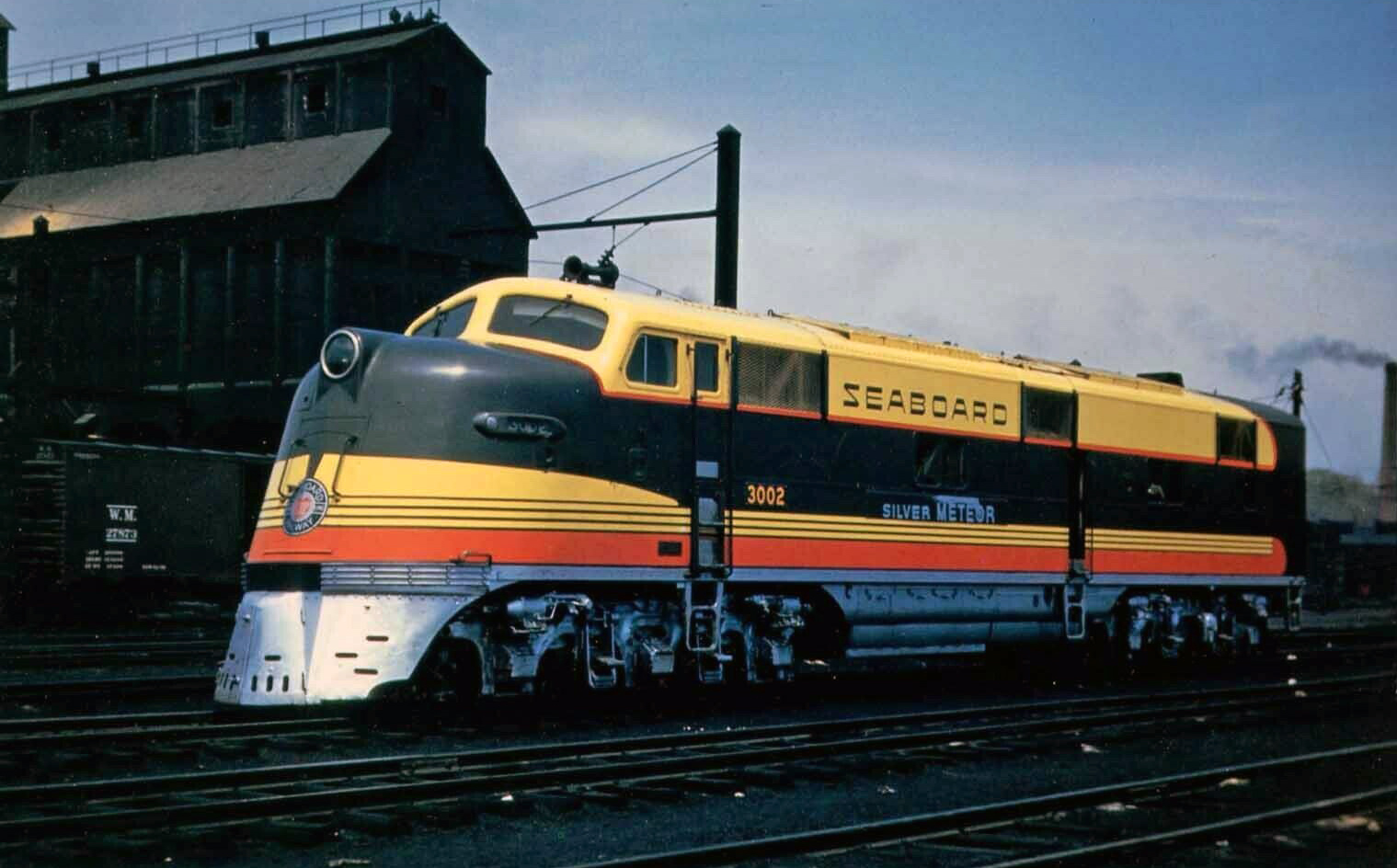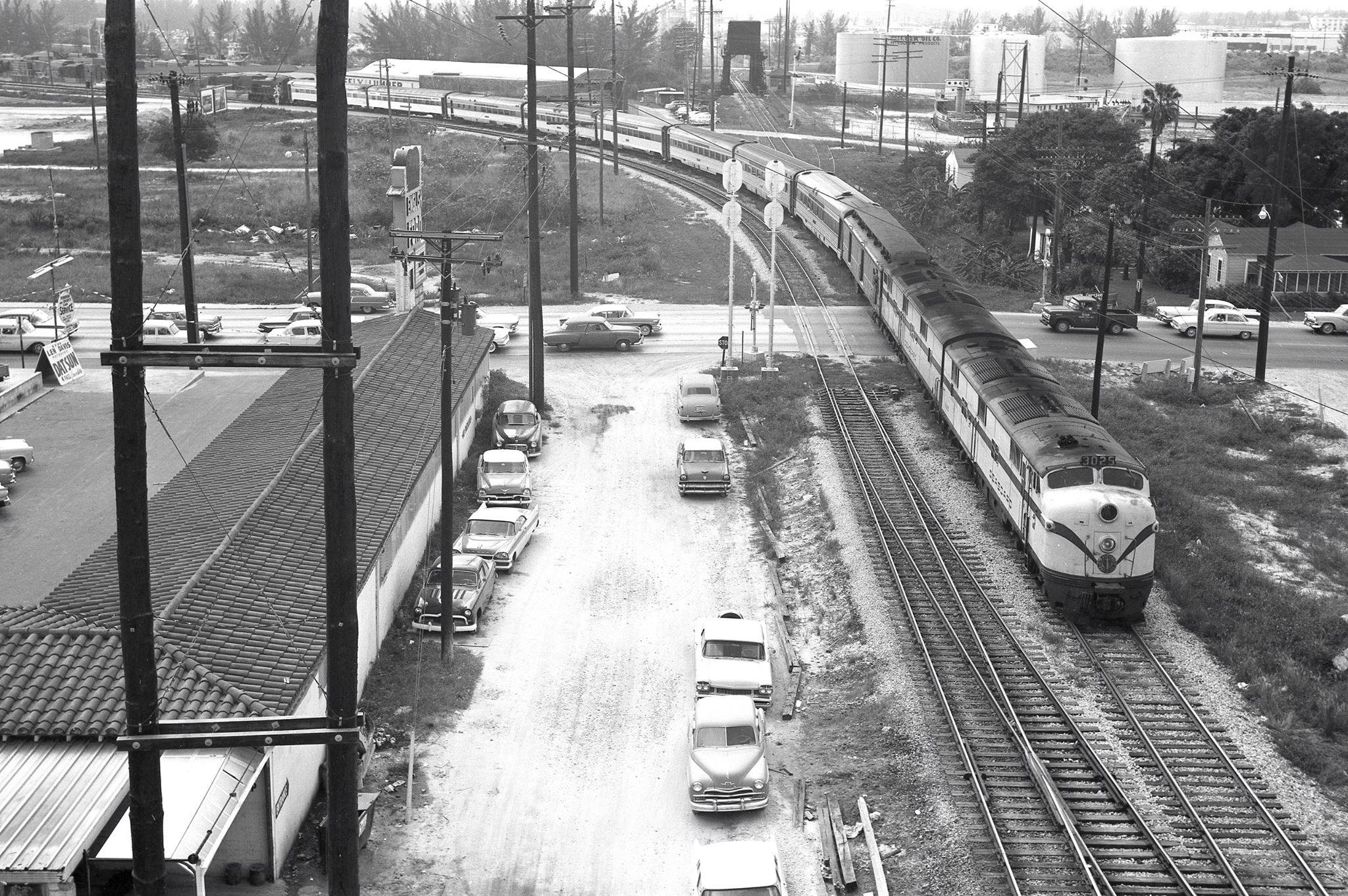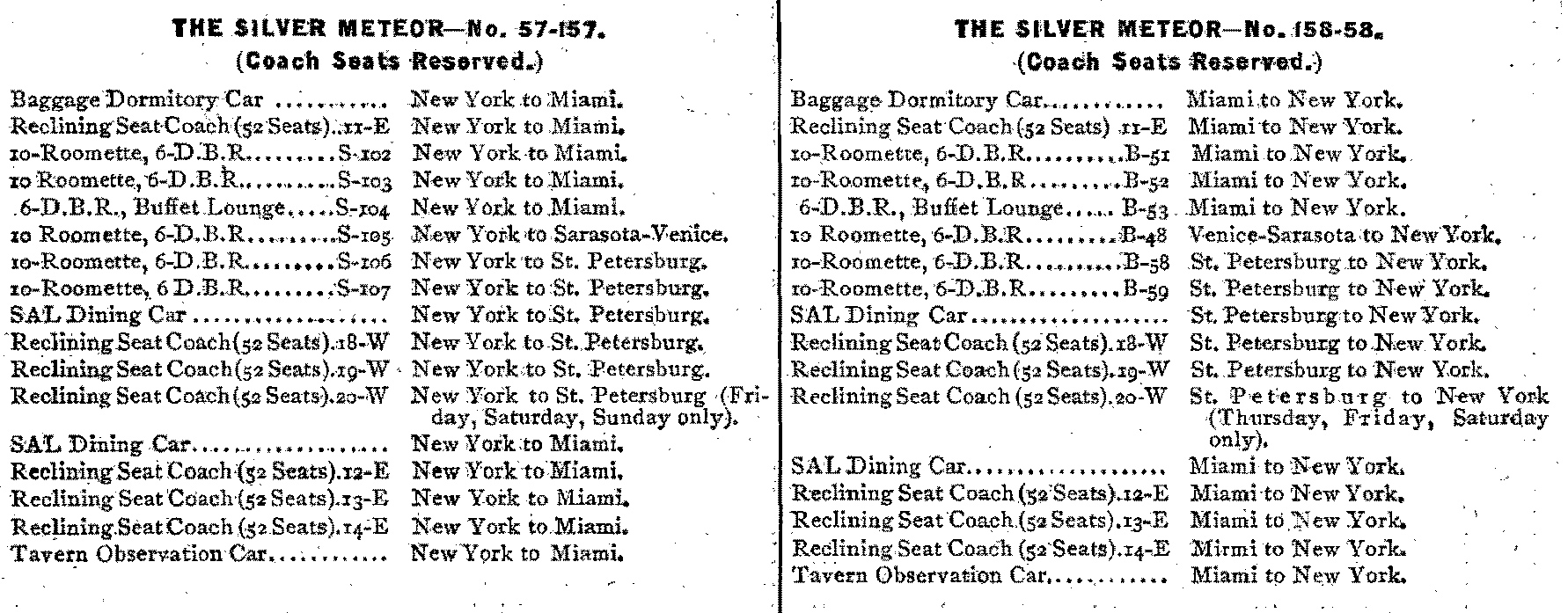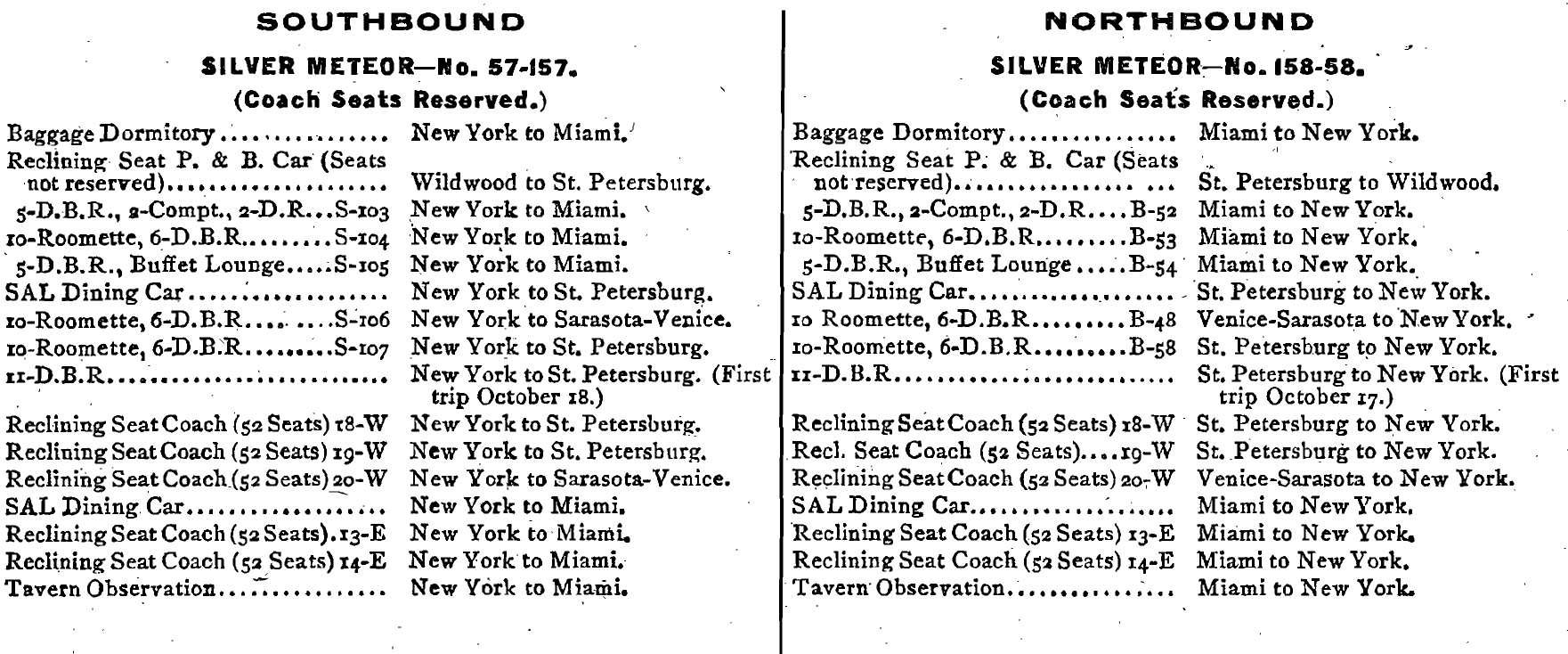The "Silver Meteor": A First-Class Florida Train
Last revised: August 25, 2024
By: Adam Burns
During the heyday of streamliners there were many colorful and attractive trains to ride if you were heading south to sunny Florida and the Seaboard Air Line Railroad’s Silver Meteor
was one of those.
While the Seaboard (also known as the SAL) kicked off the streamliner passenger train craze to serve southern destinations other railroads soon followed suit, like rival Atlantic Coast Line Railroad which inaugurated its New York-Miami Champion during late 1939, a few months after the Meteor.
Interestingly, it would be the train's name that would live on under Amtrak as the national passenger carrier discontinued the Champion in the late 1970s.
The ACL and SAL were perhaps the only two railroads in the country to serve markets so highly demanded by passengers.
Ever since the late 1800s when Florida became more accessible to the public (by means of Henry Flagler’s Florida East Coast Railway, which was chartered in 1895 to link the entire eastern shoreline of Florida), vacationers and travelers, particularly from the northern states, were enamored with its tropical weather, warm breezes, and beautiful beaches.
Photos
 Seaboard Air Line E4A #3002 provides a brilliant splash of color to the Ivy City engine terminal in Washington, D.C. on May 6, 1940 at 12:35 PM as it awaits its next assignment pulling the "Silver Meteor." Leonard W. Rice photo.
Seaboard Air Line E4A #3002 provides a brilliant splash of color to the Ivy City engine terminal in Washington, D.C. on May 6, 1940 at 12:35 PM as it awaits its next assignment pulling the "Silver Meteor." Leonard W. Rice photo.History
This tropical climate gave both railroads an unprecedented marketing advantage not found on most other systems. Even as passenger train traffic took serious hits beginning in the 1950s from highways and airlines, across the industry both the Seaboard Air Line and Atlantic Coast Line Railroads continued to earn strong revenue with their Florida-bound trains all of the way up through the 1960s!
Each company had the vacation market cornered and were the only railroads to provide direct service to Florida via the Mid-Atlantic region (as well as Midwestern areas via connections).
A testament to this popularity can be seen in the number of passenger trains both railroads offered to points south.
The Seaboard offered such trains as:
- Cotton Blossom (Washington, D.C. – Atlanta)
- Gulf Wind (Jacksonville – New Orleans)
- New York – Florida Special (New York – Miami/St. Petersburg)
- Orange Blossom Special (New York – Miami)
- Palmland (New York – Tampa/Boca Grande, Florida)
- Silver Meteor (New York – Miami)
- Silver Comet (New York – Birmingham)
- Silver Star (New York – Miami: A train actually introduced to meet the demand of the Silver Meteor’s route!)
- Sunland (Washington, D.C./Portsmouth, Virginia – Miami)
- Suwanee River Special (Cincinnati – Florida)
At A Glance
25 Hours and 45 Minutes (Southbound) 25 Hours and 25 Minutes (Northbound) | |
24 Hours and 30 Minutes (Southbound) 24 Hours and 40 Minutes (Northbound) | |
February 2, 1939 - June 30, 1967 (Seaboard Air Line) July 1, 1967 - April 30, 1971 (Seaboard Coast Line) May 1, 1971 - Present (Amtrak) | |
113/57 (Southbound) 114/58 (Northbound) | |
1388.7 Miles (New York - Miami) | |
Pennsylvania Station (New York) Seaboard Station/2206 Northwest 7th Avenue (Miami) Seaboard Station/420 22nd Street South (St. Petersburg) |
While service to Florida had been brisk for both railroads for decades, it wasn’t until the streamlined, and very colorful, Silver Meteor debuted on February 2, 1939 did southern passenger railroading take on a whole new level of service.
The original version of the Silver Meteor was a lightweight, seven car, all-coach affair (including diner service). However, although it was only all-coach service, it was extremely successful.
Consist (1952/1958)
Advertised as an overnight train between New York/Boston and Miami (with through sleeper service available via the Pennsylvania and New Haven railroads) it featured stainless-steel cars (built by the Budd Company) with livery adorning the new EMD E4 diesel locomotives, which was as colorful and bright as Florida itself.
The classic paint scheme featured blends of bright yellow and orange with a center color of very dark green with bright silver featured along the bottom (including the trucks).
The bright livery adorning the Meteor became a signature feature of both the ACL and SAL Florida-bound trains as they exuded bright, cheery themes meant to give passengers a glimpse of the sub-tropical/tropical weather in which they were heading.
The success of the original Meteor meant that the train would not remain an all-coach only affair for long. After World War II it was upgraded with features such as sleepers and lounges (including the 1956 introduction of the “Sun Lounge”, a car with glass ceilings to allow in natural light; clearance restrictions prevented domes to New York City) giving the train much more diversity and options for passengers.
Timetable (1941)
| Read Down Time/Leave (Train #113/PRR) | Milepost | Location | Read Up Time/Arrive (Train #114/PRR) |
|---|---|---|---|
| 2:05 PM (Dp) | 0.0 | 11:15 AM (Ar) | |
| 2:20 PM | 10.0 | 10:58 AM | |
| 3:04 PM | 58.1 | 10:14 AM | |
| 3:32 PM | 85.9 | 9:48 AM | |
| 3:40 PM (Ar) | 9:39 AM (Dp) | ||
| 3:41 PM (Dp) | 9:38 AM (Ar) | ||
| 4:14 PM | 118.1 | F 9:08 AM | |
| 5:14 PM (Ar) | 186.5 | 8:06 AM (Dp) | |
| 5:15 PM (Dp) | 186.5 | 8:05 AM (Ar) | |
| 6:05 PM (Ar) | 226.6 | 7:25 AM (Dp) | |
| Time/Leave (Train #43/RF&P) | Milepost | Location | Time/Arrive (Train #44/RF&P) |
| 6:20 PM (Dp) | 226.6 | 7:05 AM (Ar) | |
| 8:45 PM (Ar) | 343.1 | 4:35 AM (Dp) | |
| Time/Leave (Train #33/SAL) | Milepost | Location | Time/Arrive (Train #34/SAL) |
| 8:45 PM (Dp) | 343.1 | 4:35 AM (Ar) | |
| 9:11 PM | 365.8 | 4:01 AM | |
| F | 596.9 | F | |
| 3:15 AM | 702.8 | 9:55 PM | |
| 5:35 AM (Ar) | 843.7 | 7:30 PM (Dp) | |
| 5:40 AM (Dp) | 843.7 | 7:25 PM (Ar) | |
| 6:41 AM | 911.0 | 6:16 PM | |
| 8:00 AM (Ar) | 982.7 | 5:10 PM (Dp) | |
| 8:05 AM (Dp) | 982.7 | 5:05 PM (Ar) | |
| 8:44 AM | 1026.9 | 4:19 PM | |
| 8:55 AM | 1038.5 | 4:07 PM | |
| 9:33 AM | 1083.8 | 3:30 PM | |
| 10:00 AM (Ar) | 1109.9 | 3:05 PM (Dp) | |
| Time/Leave (Train #43/Miami Section) | Milepost | Location | Time/Arrive (Train #44/Miami Section) |
| 10:10 AM (Dp) | 1109.9 | 2:55 PM (Ar) | |
| 11:05 AM | 1109.9 | 1:44 PM | |
| 11:15 AM | 1184.2 | 1:37 PM | |
| 11:35 AM | 1206.9 | 1:16 PM | |
| 11:45 AM | 1215.9 | 1:06 PM | |
| 1:11 PM | 1318.6 | 11:40 AM | |
| 1:18 PM | 1325.2 | 11:31 AM | |
| 1:29 PM | 1336.2 | 11:20 AM | |
| 1:58 PM | 1361.0 | 10:55 AM | |
| 2:06 PM | 1368.4 | 10:47 AM | |
| 2:35 PM (Ar) | 1388.7 | 10:20 AM (Dp) | |
| Time/Leave (Train #343/St. Petersburg Section) | Milepost | Location | Time/Arrive (Train #344/St. Petersburg Section) |
| 10:15 AM (Dp) | 1109.9 | 2:50 PM (Ar) | |
| 11:00 AM | 1146.5 | 1:58 PM | |
| 11:32 AM | 1171.4 | 1:26 PM | |
| 12:05 PM (Ar) | 1193.4 | 12:55 PM (Dp) | |
| 12:10 PM (Dp) | 1193.4 | 12:50 PM (Ar) | |
| 12:29 PM | 1199.9 | 12:29 PM | |
| F 12:47 PM | 1213.6 | F 12:09 PM | |
| F 12:53 PM | 1218.7 | F 12:03 PM | |
| 1:03 PM | 1226.1 | 11:52 AM | |
| 1:12 PM | 1227.5 | 11:43 AM | |
| 1:15 PM | 1229.4 | 11:41 AM | |
| 1:27 PM | 1236.5 | 11:34 AM | |
| 1:32 PM | 1241.6 | 11:29 AM | |
| 1:50 PM (Ar) | 1247.3 | 11:15 AM (Dp) |
A typical consist during the late 1950s included reclining-seat coaches, a diner, lounge, sleepers, and tavern observation. Listed as Trains #57 (southbound) and #58 (northbound) on Seaboard's timetable, the Silver Meteor would depart Pennsylvania Station at 2:55 pm, powered by PRR GG1s until reaching Washington, D.C. where the train was handed off, about four hours later, to the Richmond, Fredericksburg & Potomac.
The
RF&P carried the train another few hours until reaching Richmond's
Main Street Station before 10 pm. From this point the Seaboard carried
its train the rest of the way to Florida, arriving in Miami by nearly 5
pm the next day (the train also provided connecting service to Tampa,
Venice, and St. Petersburg).
 An A-B set of Seaboard Air Line E7's have what may be the "Silver Meteor" (New York - Miami/St. Petersburg/Venice/Fort Meyers) at the Hialeah Market in Miami, Florida during the 1960s. Warren Calloway photo.
An A-B set of Seaboard Air Line E7's have what may be the "Silver Meteor" (New York - Miami/St. Petersburg/Venice/Fort Meyers) at the Hialeah Market in Miami, Florida during the 1960s. Warren Calloway photo.Amtrak and Final Years
Much like the Atlantic Coast Line, the Seaboard Air Line Railroad took great pride in its passenger train operations and they remained flawlessly operated with excellent service until the SAL disappeared into the Seaboard Coast Line in 1967.
Under the SCL high quality service was retained (although the train's livery was a much more subdued black with yellow trim) as one could still purchase sleeper service to New York/Boston and the train retained its diner, reclining-seat coaches, and tavern-observation lounge.
As a testament to the SAL’s high quality of
passenger operations and lucrative southern market, Amtrak continues to
operate several of its trains including the Meteor (as well as the Silver Star), and in 1979 elected to discontinue the Atlantic Coast Line's Champion.
Sources
- Goolsby, Larry. Seaboard Air Line Passenger Service, The Streamlined Era. Forest: TLC Publishing, 2011.
- Schafer, Mike. More Classic American Railroads. Osceola: MBI Publishing, 2000.
- Schafer, Mike and Welsh, Joe. Streamliners, History of a Railroad Icon. St. Paul: MBI Publishing, 2003.
- Solomon, Brian. Streamliners: Locomotives And Trains In The Age Of Speed And Style. Minneapolis: Voyageur Press, 2015.
Recent Articles
-
Ohio Short Line Railroads: A Complete Guide
Mar 27, 25 12:40 PM
This information highlights the currently active Class 3 short lines operating within the state of Ohio. -
Pennsylvania Short Line Railroads: A Complete Guide
Mar 27, 25 12:37 PM
Highlighted here is a complete list of active Class 3 short line railroads operating within the state of Pennsylvania. -
California Pumpkin Train Rides (2025): A Complete Guide
Mar 27, 25 12:25 PM
There is one location in California hosting the popular pumpkin train, at the Roaring Camp Railroads. Learn more about these event!


